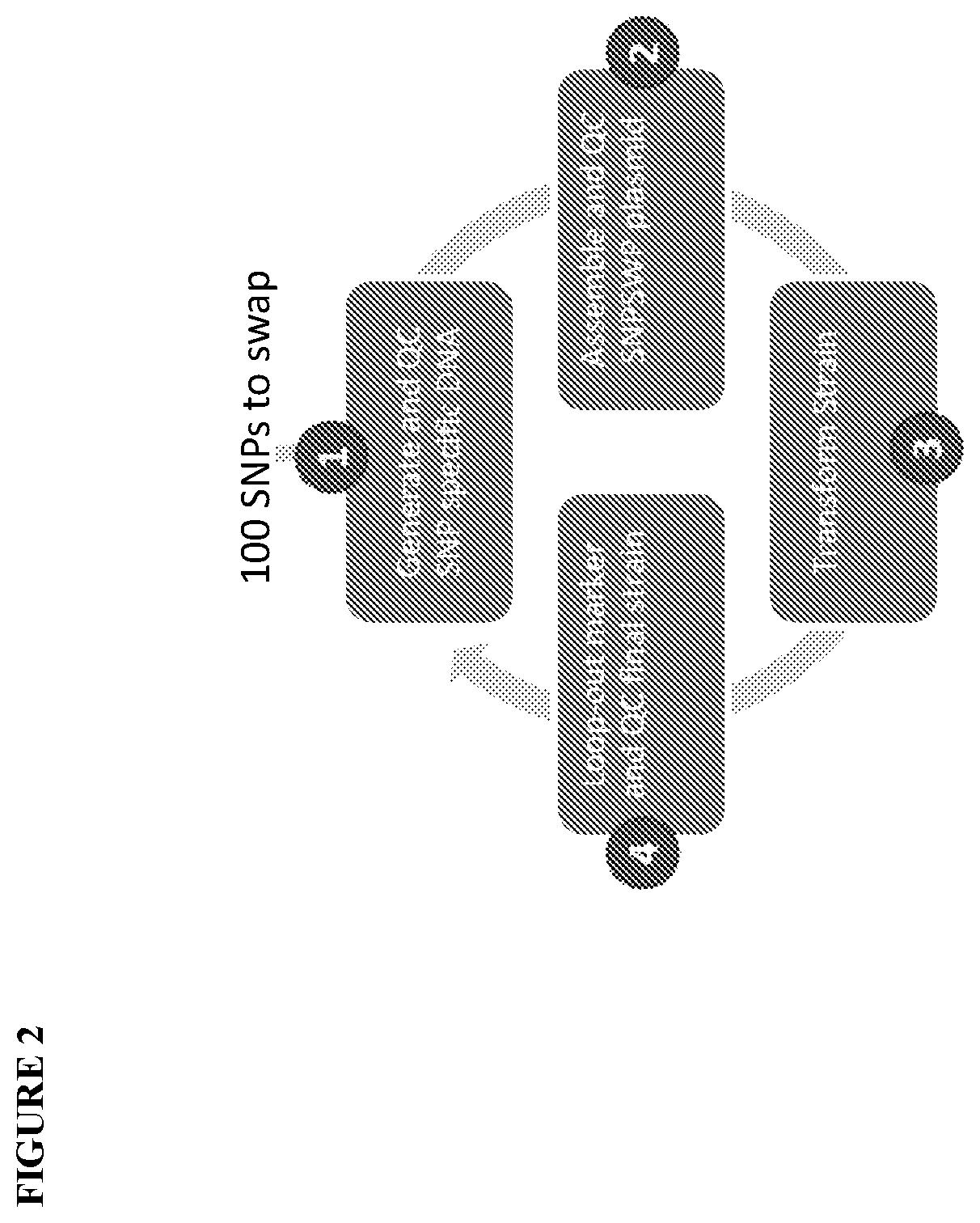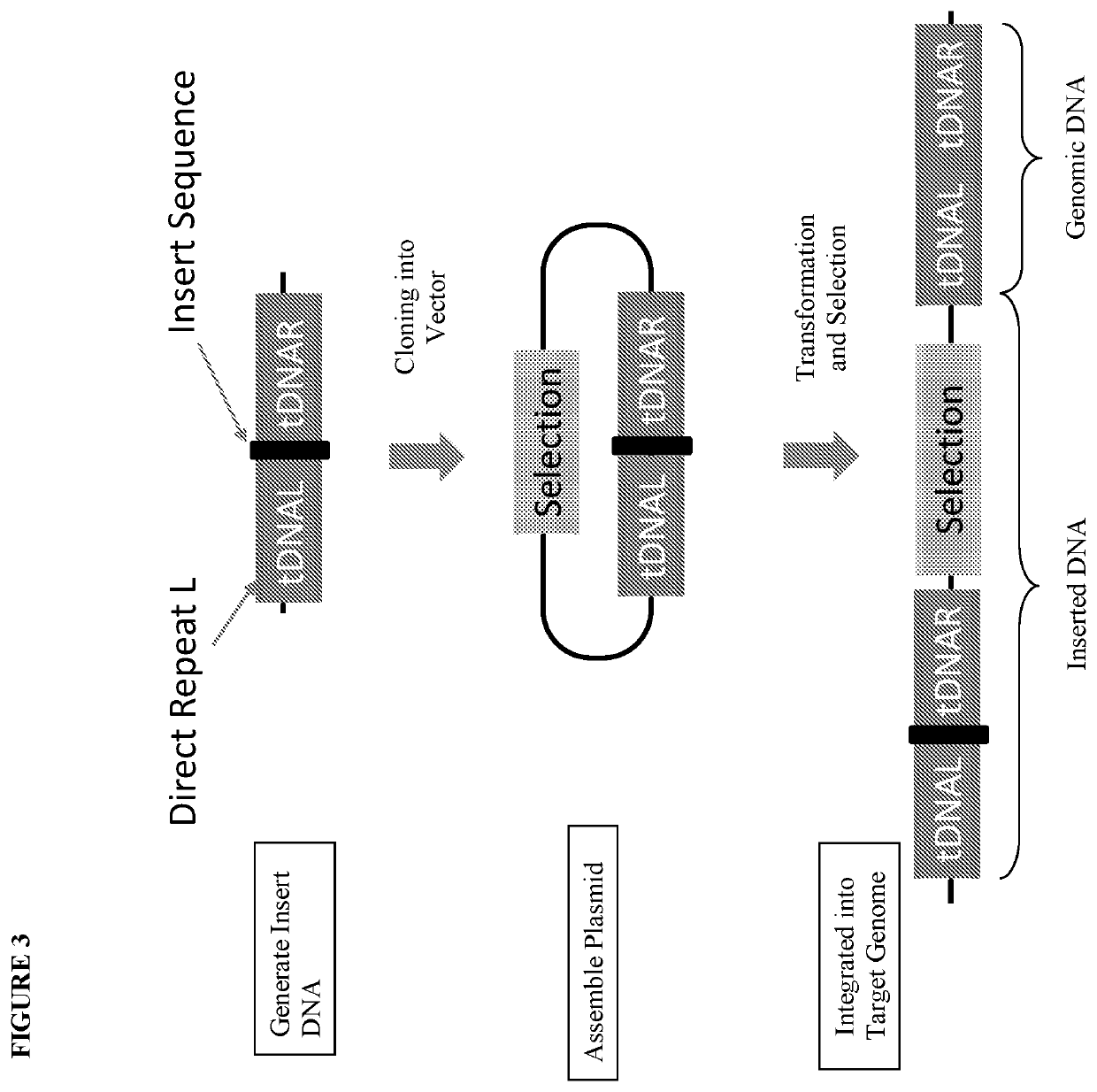However, identification of improved industrial microbial strains through a traditional
mutagenesis process is
time consuming and inefficient.
The process, by its very nature, is haphazard, inefficient, and slow.
First, many industrial organisms were (and remain) poorly characterized in terms of their genetic and metabolic repertoires, rendering alternative directed improvement approaches difficult, if not impossible.
Second, even in relatively well characterized systems, genotypic changes that result in industrial performance improvements are difficult to predict, and sometimes only manifest themselves as epistatic phenotypes requiring cumulative mutations in many genes of known and unknown function.
Additionally, for many years, the genetic tools required for making directed genomic mutations in a given industrial
organism were unavailable, or very slow and / or difficult to use.
The extended application of the traditional strain improvement programs, however, yield progressively reduced gains in a given strain lineage, and ultimately lead to exhausted possibilities for further strain efficiencies.
Beneficial random mutations are relatively rare events, and require large screening pools and high
mutation rates.
This inevitably results in the inadvertent accumulation of many neutral and / or detrimental (or partly detrimental) mutations in “improved” strains, which ultimately create a drag on future efficiency gains.
Another limitation of traditional cumulative improvement approaches is that little to no information is known about any particular
mutation's effect on any strain metric.
This fundamentally limits a researcher's ability to combine and consolidate beneficial mutations, or to remove neutral or detrimental mutagenic “baggage.”
However, these approaches are subject to many limitations that are circumvented using the methods of the present disclosure.
For example, traditional recombinant approaches as described above are slow and rely on a relatively small number of random recombination
crossover events to swap mutations, and are therefore limited in the number of combinations that can be attempted in any given cycle, or time period.
In addition, although the natural recombination events in the prior art are essentially random, they are also subject to
genome positional bias.
Most importantly, the traditional approaches also provide little information about the influence of individual mutations and due to the random distribution of recombined mutations many specific combinations cannot be generated and evaluated.
For example, traditional mutagenesis-based methods of developing an industrial microbial strain will eventually lead to microbes burdened with a heavy mutagenic load that has been accumulated over years of random mutagenesis.
The ability to solve this issue (i.e. remove the genetic baggage accumulated by these microbes) has eluded microbial researchers for decades.
By varying the expression levels of a set of proteins systematically, function can be altered in ways that, because of complexity, are difficult to predict.
Because these interactions are sequentially linked, this
system exhibits distributed control, and increasing the expression of one
enzyme can only increase pathway flux until another
enzyme becomes
rate limiting.
MCA is limited however, because it requires extensive experimentation after each expression level change to determine the new
rate limiting enzyme.
Further, because the read-out on function is better production of the
small molecule of interest, the experiment to determine which enzyme is limiting is the same as the
engineering to increase production, thus shortening development time.
These rational methods reduce the number of perturbations that must be tested to find one that improves performance, but they do so at significant cost.
Due to the complexity of
protein interactions, this is often ineffective at increasing performance.
The assumptions that underlie these models are simplistic and the parameters difficult to measure, so the predictions they make are often incorrect, especially for non-model organisms.
Random approaches to generating genomic mutations such as
exposure to UV
radiation or
chemical mutagens such as
ethyl methanesulfonate were a preferred method for industrial strain improvements because: 1) industrial organisms may be poorly characterized genetically or metabolically, rendering target selection for directed improvement approaches difficult or impossible; 2) even in relatively well characterized systems, changes that result in industrial performance improvements are difficult to predict and may require perturbation of genes that have no known function, and 3) genetic tools for making directed genomic mutations in a given industrial
organism may not be available or very slow and / or difficult to use.
However, despite the aforementioned benefits of this process, there are also a number of known disadvantages.
This often results in unwanted neutral and partly detrimental mutations being incorporated into strains along with beneficial changes.
Over time this ‘mutagenic burden’ builds up, resulting in strains with deficiencies in overall robustness and key traits such as growth rates.
Eventually ‘mutagenic burden’ renders further improvements in performance through random mutagenesis increasingly difficult or impossible to obtain.
Without suitable tools, it is impossible to consolidate beneficial mutations found in discrete and parallel branches of strain lineages.
For example, as these approaches rely on a relatively small number of random recombination
crossover events to swap mutations, it may take many cycles of recombination and screening to optimize strain performance.
In addition, although natural recombination events are essentially random, they are also subject to
genome positional bias and some mutations may be difficult to address.
These approaches also provide little information about the influence of individual mutations without additional
genome sequencing and analysis.
A rare codon induced translational pause includes the presence of codons in the
polynucleotide of interest that are rarely used in the
host organism may have a negative effect on
protein translation due to their scarcity in the available tRNA
pool.
Such repeats can also cause slippage of
RNA polymerase.
The present transposon mutagenesis HTP molecular tool solves two problems: First, there is a lack of understanding of
genotype-
phenotype relationships.
Even in well-studied organisms, large portions of the genomic landscape remain poorly understood.
Further, well-understood genetic elements may interact in unexpected ways.
Second, with slow-growing or genetically recalcitrant organisms, especially those with large genomes, it is time and / or cost prohibitive to perform targeted genetic perturbations on all possible genetic targets
Certain tools described in the present disclosure concerns existing polymorphs of genes in microbial strains, but do not create novel mutations that may be useful for improving performance of the microbial strains.
1. Selecting a transposon
system for mutagenesis and applying the
system in a given microbial strain to generate mutations (or any other genetic perturbation, but
mutation will be used for simplicity in this synopsis) caused by the transposon. Ideally the system is shown to lead to random integration of transposon into the genome of a selected microbial strain. Such integration perturbs
gene expression in some way.
2. High-
throughput strain engineering to rapidly select strains having integrated transposon in its genome. In this way a “
library” (also referred to as a HTP
genetic design library, i.e. a transposon mutagenesis microbial strain
library) of strains is constructed, wherein each member of the library is a strain comprising a transposon mutation, in an otherwise identical genetic context. As previously described, combinations of mutations can be consolidated, extending the range of combinatorial possibilities upon which the library is constructed.
3. High-throughput screening of the library of strains in a context where their performance against one or more
metrics is indicative of the performance that is being optimized.
As previously explained, the optimization of microbes for use in
industrial fermentation is an important and difficult problem, with broad implications for the economy, society, and the natural world.
Such approaches are also limited by the rarity of beneficial mutations, the ruggedness of the underlying fitness landscape, and more generally underutilize the state of the art in cellular and
molecular biology.
In practice, such rational approaches are confounded by the underlying complexity of
biology.
Causal mechanisms are poorly understood, particularly when attempting to combine two or more changes that each has an observed beneficial effect.
However, at the same time, the present HTP platform faces the problem of being fundamentally limited by the combinatorial explosive size of genomic space, and the effectiveness of computational techniques to interpret the generated data sets given the complexity of genetic interactions.
However, for full genomic optimizations for biomolecules, such residue-centric approaches are insufficient for some important reasons.
First, because of the exponential increase in relevant sequence space associated with genomic optimizations for biomolecules.
Second, because of the added complexity of regulation, expression, and metabolic interactions in
biomolecule synthesis.
In one embodiment, sequencing chemistries are employed having relatively high error rates.
Predicted strains that are similar to ones that have already been built could result in time and
cost savings despite not being a top predicted candidate
When constructing the aforementioned models, one cannot be certain that genetic changes will truly be additive (as assumed by
linear regression and mentioned as an assumption above) due to the presence of epistatic interactions.
In the absence of training data, embodiments may employ unsupervised
machine learning.
In practice, the build process has an expected
failure rate whereby a random set of strains is not built.
However, the synthesized oligonucleotides are of lesser quality than when using
solid support synthesis (See Tian infra.
 Login to View More
Login to View More 


